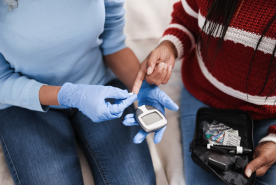What is C3G?
C3G stands for complement 3 glomerulopathy. The "C3" refers to a blood protein that plays a key role in normal immunity and in the development of this disease. More on this later. The "G" is for glomerulopathy, meaning damage to the glomeruli in the kidney. Glomeruli filter your blood to get rid of toxins and make urine.

The term C3G includes dense deposit disease (DDD) and C3 glomerulonephritis (C3GN); these are two patterns of damage and inflammation in the glomeruli. In other words, the damage and inflammation in the kidney tissue in DDD looks different from that in C3GN when seen under a microscope.
The above names are new. It's important to know the history of the naming system for C3G because some patients who were diagnosed with the disease before the new names were introduced know their disease by a different name. Before 2013, a portion of C3G patients carried the diagnosis of "membranoproliferative glomerulonephritis (MPGN)" or "mesangioproliferative glomerulonephritis." These same patients would now be called C3G based on the microscopic appearance of their glomeruli and according to the new definition of the disease.
Old name | New name |
MPGN 1 or 3 (About 1/3 of cases) | C3 glomerulonephritis (C3GN) |
MPGN 2 (All cases) | Dense deposit disease (DDD) |
C3G
Sign up for a deep dive into Complement 3 Glomerulopathy (C3G)
Learn about Complement 3 Glomerulopathy (C3G), receive additional resources, and learn so much more.
What causes C3G?
To understand the cause of C3G, it's important to know about the complement system (the "C" in C3G). This system is a collection of proteins in the blood that, when functioning properly, help (complement) the immune system to fight invaders such as bacteria and viruses. However, when the complement system becomes abnormally activated, such as in C3G, normal complement proteins such as C3 can be broken down. Breakdown products of C3 become lodged in the kidney, setting off reactions that injure the glomeruli. Damaged glomeruli can't filter the blood very well, and urine production is reduced. If this continues, toxins can build up in the blood, more kidney tissue can become damaged, and the ability of the kidney to perform other important functions may decline.
There are several reasons why the complement system is abnormally active in C3G. First, certain proteins in the complement system normally put the brakes on the system. Without these regulatory proteins, the complement system operates uncontrollably. Genetic changes (mutations) in these regulatory proteins can reduce their ability to control the complement system when it needs control. Second, abnormal proteins (called antibodies) may develop that prevent the otherwise normal braking process. This leads to a poorly controlled complement system. These are called either genetic or acquired drivers of C3G.
Whatever the cause of the poorly controlled complement system, this lack of control is the inciting process that damages the glomeruli. C3G is now considered a disease of a poorly regulated complement system.
What are the signs and symptoms of C3G?
Common signs and symptoms of C3G are:
- Blood in the urine (hematuria)
- Excess protein in the urine (proteinuria)
- Reduced glomerular filtration rate (GFR; reduced ability of the kidney to filter the blood and make urine), elevated creatinine
- Fatigue
- Swelling (edema) of hands, feet, ankles
What tests are done to find out if I have C3G?
Urine test: A urine test will see if you have protein and blood in your urine.
Blood test: A blood test will tell you if complement proteins are normal, and if wastes are building up in your blood.
Glomerular filtration rate (GFR): A blood test will be done to know how well your kidneys are filtering the wastes from your body.
Kidney biopsy: In this test, a tiny piece of your kidney is removed with a special needle, and looked at under special microscopes. The kidney biopsy may show lots of breakdown products of C3, without other proteins, in the glomeruli, which usually means C3G.
To see if the C3G is DDD or C3GN, other portions of the biopsy may be viewed with an electron microscope that can magnify the glomeruli thousands of times. With this method, the exact location of the C3 in the glomeruli can be seen, and depending on where the C3G is located, this determines the diagnosis of either DDD or C3GN.
How is C3G treated?
There is no FDA-approved treatment for C3G, nor are there therapies that attack the cause of C3G. Efforts to slow the process of kidney damage from C3G may include the following:
- Corticosteroids (often called "steroids")
- Immunosuppressive drugs
- ACE inhibitors and ARBs
- Diet changes
- Complement inhibitors
Corticosteroids and immunosuppressive drugs: These medications are used to calm your immune system (to which the complement system belongs) and stop it from attacking your glomeruli.
ACE inhibitors and ARBs: These are blood pressure medications used to reduce protein loss and control blood pressure.
Immunosuppressive drugs: These medications inhibit the function of your immune system. This system contributes to the kidney damage in C3G.
Diet change: Some diet changes may be needed, such as reducing salt (sodium) and protein in your food choices to lighten the load of wastes on the kidneys.
Complement inhibitors: There is high interest in the possibility that drugs that inhibit the complement system might become an effective treatment for C3G. No anticomplement agent has been approved for use in C3G.
Will I have kidney failure because of C3G?
You should talk with your doctor about your condition, because, like many kidney diseases, the progression of C3G is variable and depends on many factors. Your doctor will attempt to define a treatment plan that is best for you. Treatment aims to slow the progress of kidney disease and to reduce your symptoms. Over time, some patients with C3G slowly get worse until they reach kidney failure, If this occurs, you will need a kidney transplant or dialysis to stay alive. Some people respond well to treatment and may live with the disease for many years while being monitored for any signs of change.

















